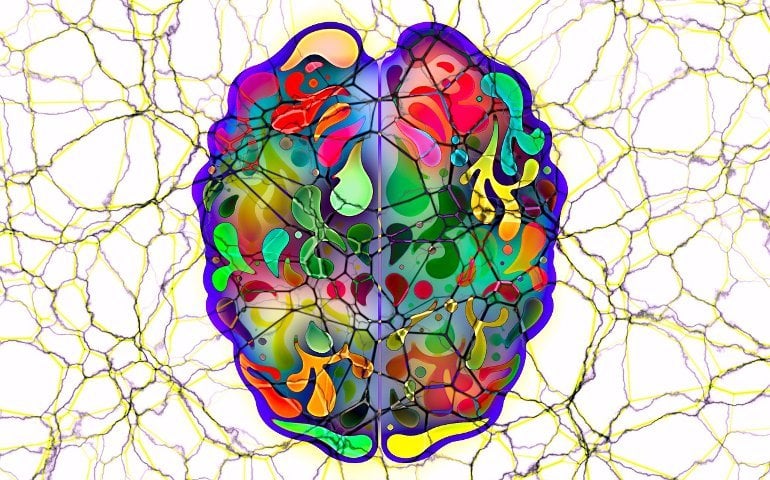Summary: Non-surgical focused ultrasound treatments significantly improve movement, tremors, and other physical symptoms of Parkinson’s disease, researchers report. Two-thirds of patients who received focused ultrasound reported improvements in symptoms for up to a year following treatment.
Source: University of Maryland
Patients with Parkinson’s disease achieved a significant improvement in their tremors, mobility, and other physical symptoms after having a minimally invasive procedure involving focused ultrasound, according to a new study today published in the New England Journal of Medicine.
The clinical trial was led by researchers at the University of Maryland School of Medicine (UMSOM) and involved 94 Parkinson’s disease patients who were randomly assigned to undergo focused ultrasound to ablate a targeted region on one side of the brain or to have a sham procedure.
Nearly 70 percent of patients in the treatment group were considered successful responders to treatment after three months of follow-up, compared to 32 percent in the control group who had an inactive procedure without focused ultrasound.
Two-thirds of those who responded initially to the focused ultrasound treatment continued to have a successful response from the treatment a year later.
Patients were treated at the University of Maryland Medical Center (UMMC), the academic flagship hospital for the University of Maryland Medical System, and 15 other sites in North America, Asia, and Europe.
“These results are very promising and offer Parkinson’s disease patients a new form of therapy to manage their symptoms. There is no incision involved, which means no risk of a serious infection or brain bleeding,” said study corresponding author Howard Eisenberg, MD, the Raymond K. Thompson Professor of Neurosurgery at UMSOM and a neurosurgeon at UMMC.
About one million Americans have Parkinson’s disease, a neurodegenerative disorder that affects brain cells or neurons in a specific area of the brain that produce the brain chemical dopamine. Symptoms include shaking, stiffness, and difficulty with balance and coordination.
Other treatments for Parkinson’s include medications and deep brain stimulation (DBS) from surgically implanted electrodes. The medications can cause involuntary, erratic movements called dyskinesia as doses are increased to control symptoms.
Usually offered when medications fail, DBS involves brain surgery to insert the electrodes through two small openings in the skull. The procedure carries a small risk of serious side effects, including brain hemorrhage and infection.
“Our study will help doctors and patients make an informed decision when considering this new treatment modality to help better manage symptoms,” said study co-author Paul Fishman, MD, Ph.D., Professor of Neurology at UMSOM and a neurologist at UMMC. “But it’s important for patients to realize that none of the treatments currently available will cure Parkinson’s disease.”
Focused ultrasound is an incisionless procedure, performed without the need for anesthesia or an in-patient stay in the hospital. Patients, who remain fully alert, lie in a magnetic resonance imaging (MRI) scanner, wearing a transducer helmet.
Ultrasonic energy is targeted through the skull to the globus pallidus, a structure deep in the brain that helps control regular voluntary movement. MRI images provide doctors with a real-time temperature map of the area being treated, to precisely pinpoint the target and to apply a high enough temperature to ablate it.
During the procedure, the patient is awake and providing feedback, which allows doctors to monitor the immediate effects of the tissue ablation and make adjustments as needed.
The device, called Exablate Neuro, was approved over a year ago by the U.S. Food and Drug Administration (FDA) to treat advanced Parkinson’s disease on one side of the brain. The FDA approval was based on findings from the UMSOM clinical trial published today. The procedure is now widely available at the University of Maryland Medical Center (UMMC). However, it is not yet covered by insurance, including Medicare, so patients currently need to pay out of pocket for the procedure.
“Focused ultrasound is only approved by the FDA to treat one side of the brain in Parkinson’s disease patients, so it may be more appropriate at this time for patients with symptoms predominantly on one side,” said study co-author Vibhor Krishna, MD, a professor of neurosurgery at the University of North Carolina, Chapel Hill.
Diagnosed with Parkinson’s disease in 2020, Melanie Carlson, a 41-year-old mother of a toddler, found that the medications she was taking to manage the condition caused her to have uncontrollable shaking. Her symptoms were so severe, she was dependent on a walker and unable to take her daughter to the playground. Last June, she opted to have focused ultrasound at UMMC after learning about the FDA approval.
“Focused ultrasound was really transformative. So many of my fine motor skills have returned. I’m putting on eyeliner again and taking showers again without falling,” Carlson said. “This honestly feels like one of the best years of my life. I just feel so fortunate. I hope more people can benefit from this procedure.”
Patients enrolled in the trial—with moderate Parkinson’s who were not responding well to medications—were treated with one session of focused ultrasound on the side of their brain that controlled the side of their body where symptoms were more severe.

The study was designed as a crossover trial, where 25 patients in the control group were offered the active treatment three months after their sham procedure; 20 out of 25 opted to have the focused-ultrasound treatment and experienced similar benefits as the initial treatment group.
Those in the treatment group had an immediate improvement of at least three points on a standard assessment—measuring tremors, walking abilities, and rigidity in the legs and arms—compared to an 0.3 point improvement in the control group.
They also experienced relief from side effects from Parkinson’s medications. They were assessed again at three months and at 12 months. Patients will continue to be followed for five years to evaluate how long the treatment lasts and progression of the disease.
Adverse events from the procedure included headache, dizziness, and nausea that resolved within a day or two of treatment. Some patients experienced mild side effects from the focused ultrasound treatment, including slurred speech, walking issues, and loss of taste. These usually resolved within the first few weeks.
Dr. Eisenberg and his colleagues are currently conducting a clinical trial to test the Exablate Neuro device on both sides of the brain, delivering focused ultrasound treatments in two sessions, six months apart.
“So far, we’ve had promising results,” Dr. Eisenberg said.
About this neurotech and Parkinson’s disease research news
Author: Press Office
Source: University of Maryland
Contact: Press Office – University of Maryland
Image: The image is in the public domain
Original Research: Closed access.
“Trial of globus pallidus focused ultrasound ablation in Parkinson’s disease” by Paul Fishman et al. NEJM
Abstract
Trial of globus pallidus focused ultrasound ablation in Parkinson’s disease
BACKGROUND
Unilateral focused ultrasound ablation of the internal segment of globus pallidus has reduced motor symptoms of Parkinson’s disease in open-label studies.
METHODS
We randomly assigned, in a 3:1 ratio, patients with Parkinson’s disease and dyskinesias or motor fluctuations and motor impairment in the off-medication state to undergo either focused ultrasound ablation opposite the most symptomatic side of the body or a sham procedure. The primary outcome was a response at 3 months, defined as a decrease of at least 3 points from baseline either in the score on the Movement Disorders Society–Unified Parkinson’s Disease Rating Scale, part III (MDS-UPDRS III), for the treated side in the off-medication state or in the score on the Unified Dyskinesia Rating Scale (UDysRS) in the on-medication state. Secondary outcomes included changes from baseline to month 3 in the scores on various parts of the MDS-UPDRS. After the 3-month blinded phase, an open-label phase lasted until 12 months.
RESULTS
Of 94 patients, 69 were assigned to undergo ultrasound ablation (active treatment) and 25 to undergo the sham procedure (control); 65 patients and 22 patients, respectively, completed the primary-outcome assessment. In the active-treatment group, 45 patients (69%) had a response, as compared with 7 (32%) in the control group (difference, 37 percentage points; 95% confidence interval, 15 to 60; P=0.003). Of the patients in the active-treatment group who had a response, 19 met the MDS-UPDRS III criterion only, 8 met the UDysRS criterion only, and 18 met both criteria. Results for secondary outcomes were generally in the same direction as those for the primary outcome. Of the 39 patients in the active-treatment group who had had a response at 3 months and who were assessed at 12 months, 30 continued to have a response. Pallidotomy-related adverse events in the active-treatment group included dysarthria, gait disturbance, loss of taste, visual disturbance, and facial weakness.
CONCLUSIONS
Unilateral pallidal ultrasound ablation resulted in a higher percentage of patients who had improved motor function or reduced dyskinesia than a sham procedure over a period of 3 months but was associated with adverse events. Longer and larger trials are required to determine the effect and safety of this technique in persons with Parkinson’s disease. (Funded by Insightec; ClinicalTrials.gov number, NCT03319485.)







